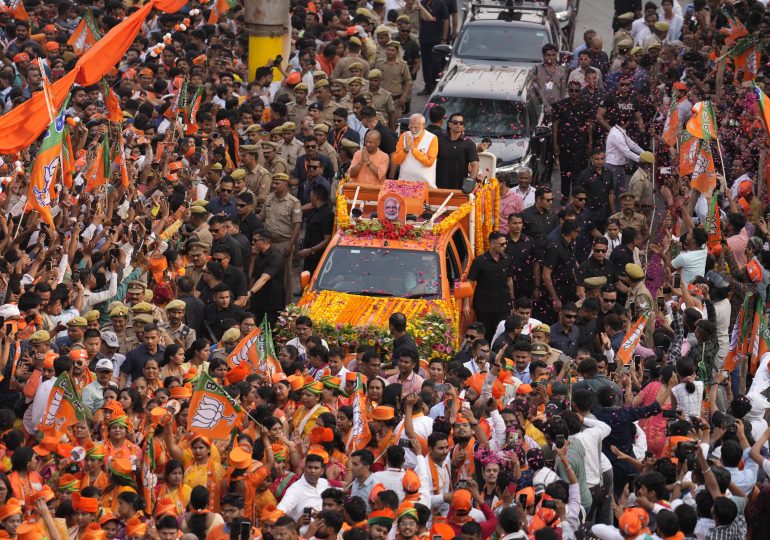After six long weeks of voting in the grueling heat, India’s election delivered stunning results.
With all of the 640 million votes now counted, Prime Minister Narendra Modi is poised to preside over a rare, third consecutive term in power—making him only the second Indian prime minister to do so after Congress leader Jawaharlal Nehru in 1962. With all its allies, Modi’s ruling Bharatiya Janata Party (BJP) has also managed to secure a majority of 283 seats in the Lok Sabha, the 543-seat lower house of India’s Parliament. Under India’s electoral system, the party or alliance that wins more than 272 seats can form a government.
[time-brightcove not-tgx=”true”]
Yet, the results have shocked most pollsters and Modi supporters—and indeed, the country. That’s because the BJP won only 240 seats this election, effectively losing the single-party majority Modi has enjoyed since he was first elected in 2014.
“Modi will have to act in a more consultative, deliberative, and inclusive manner,” says Milan Vaishnav, director of the South Asia Program at Carnegie Endowment for International Peace. “This is anathema to the PM who, going back to his days as Gujarat chief minister, has never had to truly worry about coalition politics.”
As the election draws to a close, it has brought with it a series of waves that will reshape India’s political landscape for the next five years and beyond. But ask any Indian about the election outcome and they’ll tell you that the country’s democracy is so vibrant that it never fails to surprise. “Nobody knows anything about India. This is one thing one should know about India,” one observer even posted on X.
Here are some of the most surprising takeaways from India’s 2024 election.
Busting Modi’s “400 paar” promise
This election, Modi and the BJP ran on an ambitious slogan: “Ab ki baar, 400 paar.” That meant that the ruling party was aiming to win more than 400 seats with its NDA alliance—which ultimately backfired as the BJP did not even win a simple majority on its own, a stark departure from the BJP’s thumping victory in 2019 when it won an unprecedented 303 seats. The result also means an unprecedented electoral stall for Modi, who in his 23 years in politics as the chief minister of the state of Gujarat from 2002 and then as India’s prime minister from 2014, has fallen way short of a majority despite appearing as the central face of the BJP’s campaign. (In the BJP’s 48-page manifesto, Modi’s name is featured 67 times.)
BJP loses stronghold in Uttar Pradesh
Uttar Pradesh, India’s most populous state, holds significant sway in Indian elections with 80 parliamentary seats. In 2014 and 2019, the BJP won 71 and 62 seats respectively that helped fuel the party’s rise to power in Delhi. But 2024 looks very different. The BJP won just 33 seats, while its allies secured three seats. Most notably, it lost in the Faizabad constituency, where Modi inaugurated the Ram temple in Ayodhya earlier this year, seen as a centerpiece of the BJP’s campaign.
BJP wins a seat In Kerala for the first time
The southern state of Kerala has long been seen as a bastion of the left, but the BJP finally made inroads after Suresh Gopi won by a margin of 74,686 votes in the Thrissur constituency and became the BJP’s first Lok Sabha parliamentarian from Kerala. Experts say this might reflect Islamaphobic elements among the Christian communities in Kerala, where Hindus make up 55% of the state’s population, while Muslims and Christians make up 27% and 18% respectively.
Women voters prefer Modi
Indian women, who have become a formidable force in India’s voter turnout due to political knowledge, literacy, and media exposure. Traditionally, female voters were more inclined to vote for Congress, but in the last few elections, they have redirected their votes to the BJP. A pre-poll survey predicted that 46% of India’s 472 million women voters would opt for the BJP-led alliance in the election. The reason: Modi’s welfare schemes, which have focused on women’s welfare—including cash handouts and domestic benefits like free cooking gas, piped water, and sanitation.
A Sikh separatist and Kashmir leader is elected from jail
Amritpal Singh, a 31-year-old Sikh separatist leader who was arrested last year after a month-long police manhunt in the state of Punjab, was elected a lawmaker after defeating 26 other candidates. Singh rose to prominence calling for a separate Sikh homeland known as Khalistan. Sheikh Abdul Rashid, another jailed leader from Indian-administered Kashmir in the disputed Himalayan region, won a seat by more than 200,000 votes. The former state legislator was arrested by the Modi government on charges of “terror funding” and money laundering in 2019.
Leave a comment








